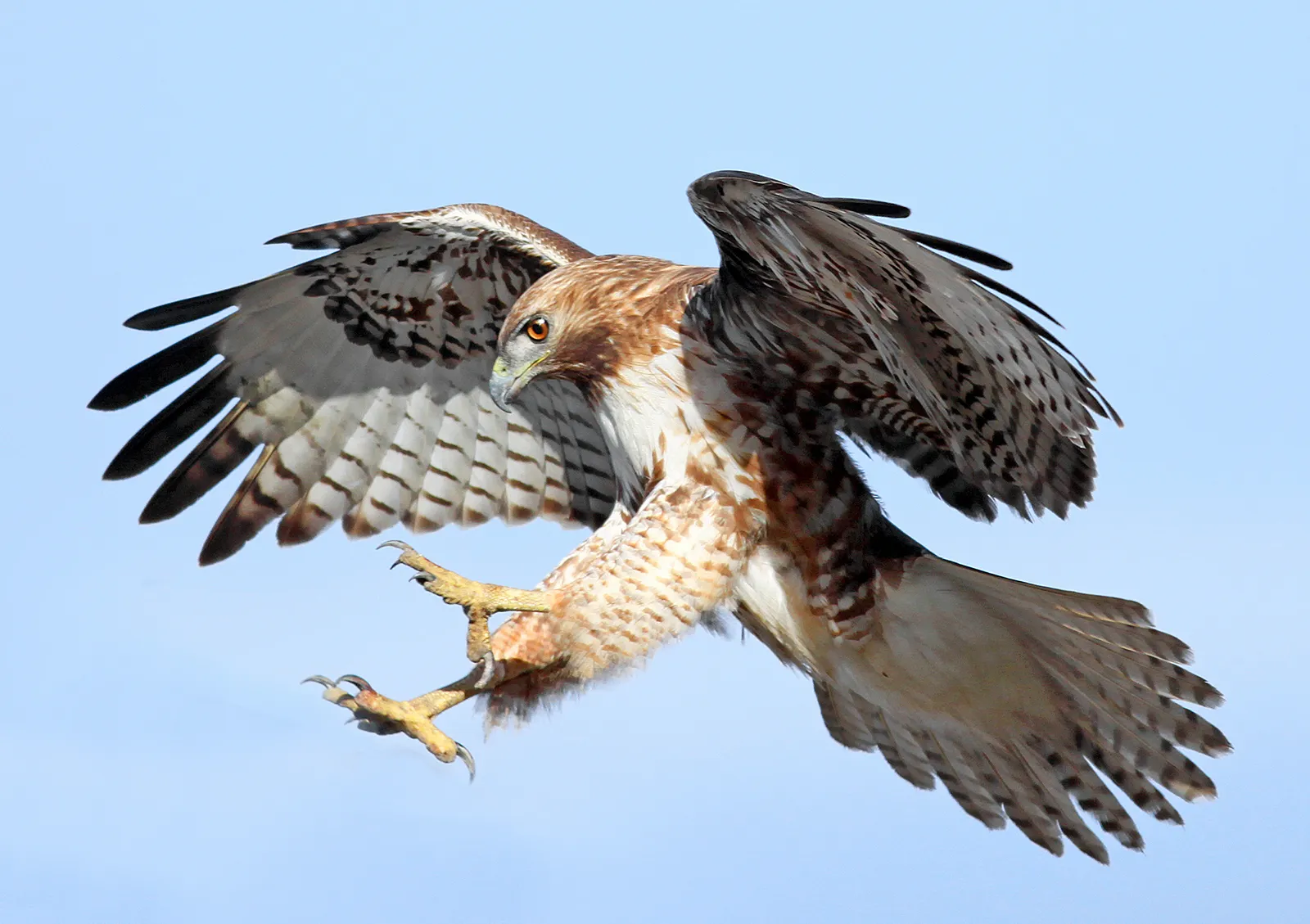
Hawks are fascinating creatures that belong to the family Accipitridae. These birds of prey have captured the imagination of humans for centuries with their impressive hunting skills and majestic appearance. With their keen eyesight, powerful wings, and sharp talons, hawks have adapted perfectly to their environment, making them efficient hunters and masters of the skies.
In this article, we will explore 19 interesting facts about hawks that will not only deepen your understanding of these magnificent birds but also inspire admiration for their unique characteristics and abilities. From their diverse species and habitats to their hunting techniques and nesting habits, hawks are a subject of intrigue and wonder. So, let’s soar into the world of hawks and unveil the secrets that make them such incredible predators.
Key Takeaways:
- Hawks are incredible birds of prey with sharp vision, curved beaks, and powerful talons. They play a vital role in controlling pest populations and have mythological significance in various cultures.
- Conservation efforts are crucial for protecting hawk populations due to threats like habitat loss and illegal hunting. Hawks symbolize nobility, strength, and keen vision in different cultures and mythologies.
Hawks belong to the family Accipitridae.
The Accipitridae family includes a wide range of diurnal raptors, with hawks being one of the most well-known and diverse groups within this family.
There are more than 250 species of hawks worldwide.
From the iconic Red-tailed Hawk of North America to the stunning Black-winged Kite of Africa, hawks can be found in various habitats across the globe.
Hawks are known for their exceptional eyesight.
With their large, forward-facing eyes, hawks have incredibly sharp vision. They can spot prey from great distances and accurately calculate their prey’s movements.
These birds have sharp, curved beaks.
The curved beak of a hawk is perfectly adapted for tearing into their prey and feeding on small mammals, birds, reptiles, and insects.
Hawks possess powerful talons.
Equipped with sharp, strong talons, hawks use their feet to catch and grip onto their prey, allowing them to capture and carry their meals while in flight.
Hawks are renowned for their swift flight.
With their long, broad wings, hawks can reach impressive speeds and execute agile maneuvers as they glide effortlessly through the sky.
They have a diverse range of hunting techniques.
From soaring high above to rapidly diving towards their prey, hawks employ various hunting strategies depending on their species and the type of prey they are targeting.
Hawks are monogamous creatures.
Once they find a mate, hawks typically form strong pair bonds and remain together for many breeding seasons.
These birds are skilled nest builders.
Hawks construct nests, known as eyries, using sticks and twigs. They usually build their nests in tall trees or on cliffs, providing a safe and elevated platform for their offspring.
Hawks are vigilant parents.
Both male and female hawks participate in raising their young, taking turns incubating the eggs and providing food for the chicks after they hatch.
Hawks have excellent hearing.
Alongside their remarkable eyesight, hawks possess acute hearing abilities, allowing them to detect faint sounds and locate prey hidden in vegetation.
Migration is a common behavior among many hawk species.
Several hawk species undertake long-distance migrations, traveling thousands of miles each year to reach their breeding or wintering grounds.
Hawks are known for their impressive territorial displays.
To defend their territory or attract a mate, hawks engage in elaborate aerial displays, showcasing their aerial skills and agility.
These birds go through molting cycles.
Hawks shed and replace their feathers periodically, ensuring their plumage remains in optimal condition for flight.
Some hawk species have specialized adaptations.
For instance, the Osprey has unique reversible outer toe joints that allow it to grasp fish with two toes in front and two toes behind, enhancing its hunting success.
Hawks have a long lifespan for birds.
Depending on the species, hawks can live up to 20 years or even longer in the wild.
Hawks play a vital role in controlling pest populations.
By feeding on rodents and other small animals, hawks help maintain a balance in ecosystems and prevent overpopulation of certain species.
Hawks have mythological and cultural significance.
Throughout history, hawks have symbolized concepts such as nobility, strength, and keen vision in various cultures and mythologies around the world.
Conservation efforts are crucial for protecting hawk populations.
Habitat loss, illegal hunting, and pollution pose significant threats to hawks, highlighting the importance of conservation initiatives to safeguard these incredible birds.
So, the next time you catch a glimpse of a hawk soaring through the sky or hear its piercing call, remember these 19 fascinating facts about hawks. These birds are not only awe-inspiring but also play a vital role in maintaining the delicate balance of nature.
Conclusion
In conclusion, hawks are fascinating creatures that have captured the awe and admiration of humans for centuries. With their impressive hunting skills, powerful wingspan, and keen eyesight, hawks are top predators in their ecosystems. Whether it’s their ability to soar gracefully in the sky or their remarkable hunting techniques, hawks never cease to amaze us.These 19 facts about hawks have shed light on the incredible world of these birds of prey. From their diverse species and habitats to their unique mating rituals and migratory patterns, there is much to learn and appreciate about these majestic creatures. So, the next time you spot a hawk gliding above you, take a moment to admire the beauty and strength of one of nature’s most remarkable hunters.
FAQs
1. What do hawks eat?
Hawks primarily feed on small mammals such as mice, voles, and rabbits. They also consume birds, reptiles, and even insects.
2. How far can hawks migrate?
Hawks have been known to migrate thousands of miles each year. Some species, like the red-tailed hawk, can travel up to 5,000 miles during their annual migration.
3. How many species of hawks are there?
There are around 270 species of hawks in the world, each with its own unique characteristics and adaptations.
4. Do hawks mate for life?
While some hawk species do mate for life, others form new pairs each breeding season.
5. Are hawks endangered?
The conservation status of hawks depends on the species. While some are considered endangered or threatened, others are more abundant.
6. How fast can hawks fly?
Hawks can reach speeds of up to 120 miles per hour during a dive or stoop.
7. Do hawks build nests?
Yes, hawks build nests using twigs, branches, and other natural materials. They typically construct their nests in trees or on cliff ledges.
8. Can hawks see in the dark?
Hawks have excellent eyesight and can see well in low-light conditions, but they are not nocturnal creatures.
9. Are hawks affected by pollution?
Pollution can have various negative effects on hawk populations, from contaminating their habitats to impairing their reproduction and overall health.
10. Can hawks be kept as pets?
In most countries, it is illegal to keep hawks as pets. They are wild animals that require specific habitats and specialized care.
Hawks' incredible hunting abilities, unique adaptations, and fascinating behaviors make them truly remarkable creatures. Delving deeper into the world of red-tailed hawks reveals even more intriguing facts about these large birds of prey. Stephen Hawking, a brilliant physicist, also left an indelible mark on our understanding of the universe through his groundbreaking work. Sharing hawk facts with kids helps foster a love for nature and an appreciation for these magnificent raptors from a young age.
Was this page helpful?
Our commitment to delivering trustworthy and engaging content is at the heart of what we do. Each fact on our site is contributed by real users like you, bringing a wealth of diverse insights and information. To ensure the highest standards of accuracy and reliability, our dedicated editors meticulously review each submission. This process guarantees that the facts we share are not only fascinating but also credible. Trust in our commitment to quality and authenticity as you explore and learn with us.


